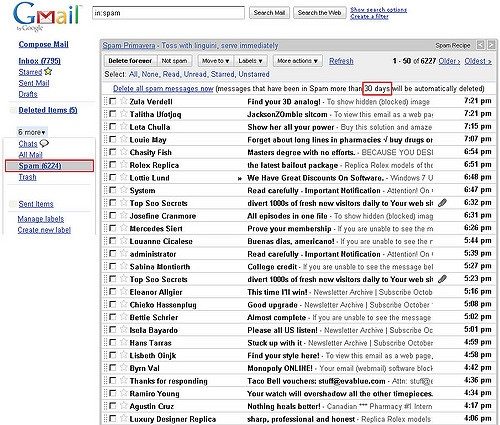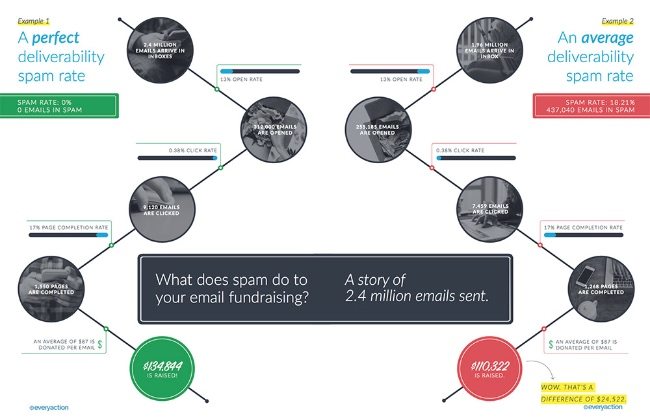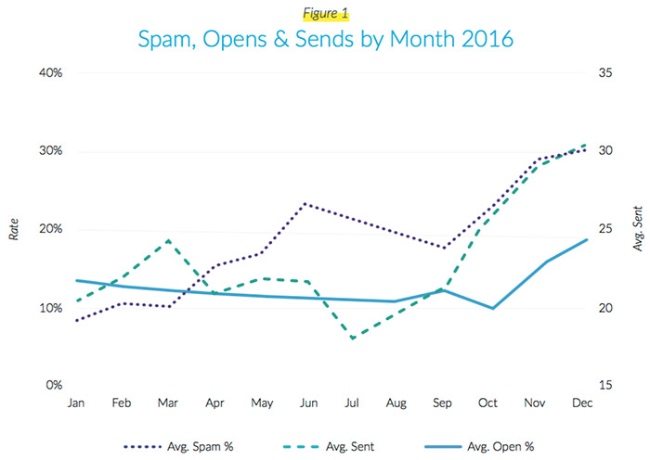
The 2017 Nonprofit Email Deliverability Study has been released, a national study in which the email marketing platform EveryAction collects deliverability data from 55 different nonprofit organizations and analyzes the impact of spam and poor deliverability on fundraising practices.
The big takeaway from this year’s study is that being classified as spam is becoming a big problem and hindering nonprofits’ email deliverability rates. If an email service provider (ESP) recognizes that the emails you send are frequently marked as spam, are immediately deleted without being opened or read, or are not engaged with or opened at all, they will likely begin routing your messages to spam or promotional folders, where they may go entirely unseen.
“Diminished engagement and soaring spam rates are significantly weighing down nonprofit fundraising potential.”
Some of the most common causes for being tagged as spam:
- Making unsubscribing difficult
- Using an out-of-date email list
- Sending irrelevant emails
- High numbers of complaints
It’s important to avoid these symptoms, because once your organization’s IP address has been flagged by an ESP as a bad sender, it might take months—or possibly years—to recover.
How Do Spam Rates Impact Fundraising?
From this study, on average, 18.21 percent of email was delivered to spam folders monthly in 2016. December saw the highest spam rate (30.25 percent) and January, the lowest (8.56 percent). The graph below shows the fundraising losses that occur when your organization’s email is hitting spam folders, using the average 18.21 percent vs. a zero-percent spam rate:

Sign up for our free newsletters
Subscribe to NPQ's newsletters to have our top stories delivered directly to your inbox.
By signing up, you agree to our privacy policy and terms of use, and to receive messages from NPQ and our partners.
“The significance of deliverability is generally overlooked—and thousands of dollars are being left on the table as a result.”
Click-through rates for fundraising emails were down 14 percent compared to the previous year. This metric, combined with a significant increase in spam rates starting in September, were the two main contributors to deliverability losses in 2016.
One vital step toward keeping deliverability rates up is to clear old defunct email addresses from your lists, along with people you are no longer reaching. EveryAction discovered from the study’s findings that about 22.2 percent in email fundraising revenue could potentially be gained by improving email deliverability rates by keeping your email lists healthy.

The report also found from the nonprofits studied that spam rates soared during the fundraising season at the end of the year, and in fact nearly tripled the previous year’s rates, climbing to 23.61 percent from 8.60 percent. The average spam rate also peaked during Giving Tuesday in 2016, with an average of 36.68 percent.
According to 2016 benchmark online giving data, every single percentage point of fundraising emails that are marked as spam could potentially result in a loss of $1,308.85 annually. These metrics further emphasize that it’s more important than ever to ensure your organization is doing all it can to stay relevant, keep its contact lists healthy, and follow ethical email practices.
What Can Else Can Be Done to Improve Email Deliverability?
- Opt-in and Confirmation: Sometimes people make mistakes and mistype their address. It’s now best practice to require new leads to opt-in to your email list, but organizations should also send a follow-up email to confirm that their email address is indeed correct.
- Incorporating a Welcome Series: A welcome series is a great way to warm contacts up and give them a sense of the content they will be receiving from your organization. A study from Return Path found that individuals who read all the messages in a welcome series would read 69 percent of that company’s email going forward. This kind of series is helpful in identifying who is most likely to be most engaged with your content.
- Beyond Opens and Clicks: ESPs are way more advanced than we’d like to imagine they are these days. For organizations tracking their progress, clicks and opens are our biggest indicators of success, but ESPs look way beyond these metrics. Segmenting out emails to cater to smaller groups based on data you’ve gathered on these contacts is a good way to gauge your audience’s interests, as is consistent use of A/B testing to asses how contacts are engaging with subject lines and content.
- Bounce Rates: Take the time to investigate why bounces are occurring, and if there’s anything you can do to remedy them. If they occur over three times with the same individual, it’s recommended that you then clean them from your system to avoid getting flagged for spamming contacts.
- Letting Go of Inactive Contacts: Inactive emails addresses are contacts that have failed to open or click an email in a significant amount of time. If these individuals continue to remain inactive for six months to a year, it’s time to cut them loose. As EveryAction states, “ESPs can turn dead email addresses into spam traps, marking all emails to that address as spam and seriously hurting your sender reputation.”
- HTML: Incorporating high quality HTML within your emails is an indication of a good sender, so make sure to clean up that coding.
- Choose Your Provider Wisely: If your nonprofit has been on the same email-marketing platform for many years and has attempted these strategies with little to no result, it may be time to look elsewhere. Although it may take an investment of time and money to do the research and make the move, if a new email platform with more advanced tools can help improve opens, click-through rates, and deliverability, then it’s well worth it. Make sure your organization is investing in an email tool that provides the metrics and support that your nonprofit deserves.











